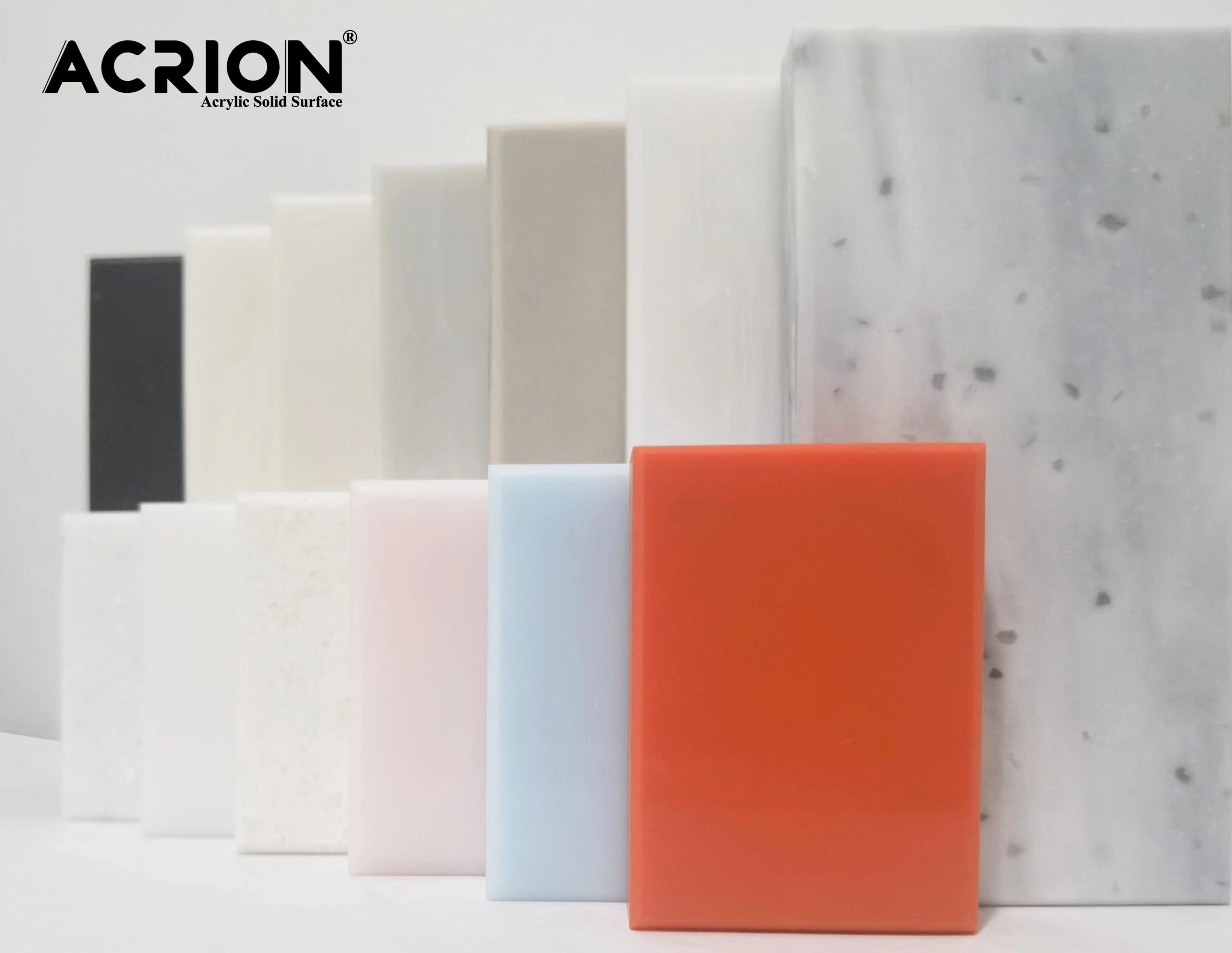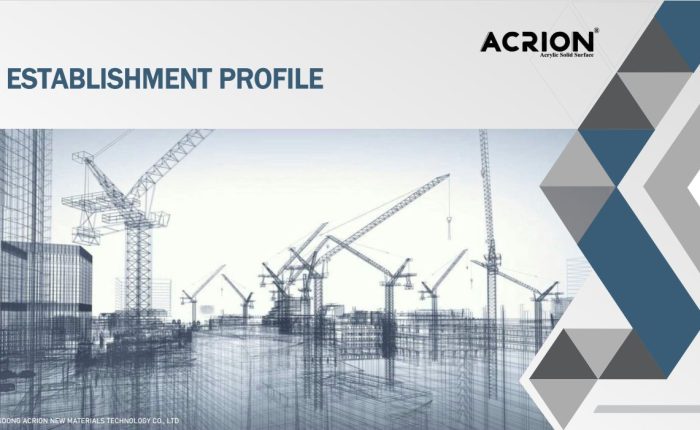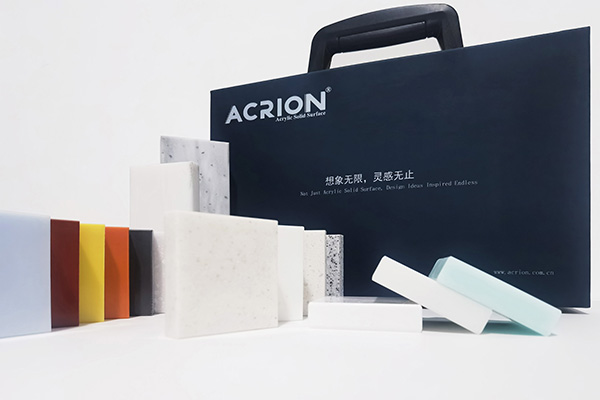Análise da flexibilidade e plasticidade de superfícies sólidas acrílicas
A flexibilidade e a plasticidade da superfície sólida do ácido acrílico são influenciadas conjuntamente pela estrutura molecular da resina, o mecanismo de cura e as condições externas. A análise a seguir é realizada a partir de três dimensões: propriedades do material, fatores de influência e cenários de aplicação:
Primeiro, as fontes e manifestações de flexibilidade
Flexibilidade da cadeia molecular
A flexibilidade da resina acrílica depende principalmente da estrutura do grupo éster (-COO-) e do grupo alquil (-R) na cadeia principal. Por exemplo, a introdução de grupos alquil de cadeia longa (como C8-C12) pode aumentar o volume livre da cadeia molecular, diminuir a temperatura de transição vítrea (TG) e, assim, aumentar a flexibilidade. Se monômeros flexíveis (como acrilato de butil) forem introduzidos na cadeia principal, o revestimento pode suportar 180 ° de flexão à temperatura ambiente sem rachaduras. No entanto, quando a proporção de monômeros duros (como o metacrilato de metila) é muito alta, a fragilidade do revestimento aumenta significativamente.
A influência da densidade de reticulação
A dosagem de agentes de reticulação (como diisocianatos e resinas epóxi) afeta diretamente a flexibilidade. Por exemplo, quando a densidade de reticulação é muito alta, o revestimento pode quebrar devido à concentração de tensão durante o teste de flexão. A reticulação moderada (como um grau de reticulação de 30 a 50%) pode equilibrar a dureza e a flexibilidade, permitindo o revestimento manter uma certa dureza e ter resistência ao impacto.
Dependência da temperatura
A flexibilidade do revestimento acrílico aumenta com o aumento da temperatura. Por exemplo, em -20 ℃, o revestimento pode exibir fraturas quebradiças; Aos 60 ℃, seu alongamento no intervalo pode aumentar em 2 a 3 vezes. Essa característica exige que, quando usado em ambientes de baixa temperatura, a fórmula precisa ser otimizada (como adicionar plastificantes) para manter a flexibilidade.
Segundo, o mecanismo de realização da plasticidade
Processamento termoplástico
A resina acrílica incompletamente curada pode obter plasticidade através do processamento termoplástico. Por exemplo, em 120-150 ℃, a resina pode ser calendada, moldada por sopro ou moldada por injeção e mantém sua forma após o resfriamento. Essa característica é aplicável à fabricação de produtos em forma de complexo (como peças decorativas em forma irregular), mas a temperatura de processamento precisa ser controlada para evitar a degradação térmica.
Modelagem assistida por solvente
A viscosidade da resina pode ser reduzida e sua plasticidade aumentada adicionando solventes voláteis (como acetato de etila). Por exemplo, quando o conteúdo de solvente é de 20 a 30%, a resina pode ser revestida ou pulverizada em uma camada fina e um revestimento denso é formado após o solvente evaporar. Este método é aplicável à construção em larga escala (como as paredes externas dos edifícios), mas é necessário prestar atenção à influência da taxa de evaporação do solvente na planicidade do revestimento.
Cura leve e reticulação reversível
Algumas resinas acrílicas podem ser fotocuradas por fotoinitiadores, enquanto as ligações reversíveis de reticulação (como ligações dissulfeto e ligações de hidrogênio) são introduzidas para aumentar a plasticidade. Por exemplo, sob irradiação da luz ultravioleta, a resina pode ser curada e formada em segundos. Sob a influência de aquecimento ou solventes específicos, as ligações de reticulação podem quebrar, alcançando a modelagem secundária. Esse recurso é aplicável a cenários que requerem processamento repetitivo (como impressão 3D).
Terceiro, os principais fatores que influenciam a flexibilidade e a plasticidade
Composição de monômeros de resina
A proporção de monômeros moles (como acrilato de etila e acrilato de isooctilo) para monômeros duros (como metacrilato de metila e estireno) afeta diretamente a flexibilidade. Por exemplo, quando a proporção de monômeros moles excede 60%, a flexibilidade do revestimento é significativamente melhorada, mas a dureza pode ser insuficiente. Quando a proporção de monômeros duros é muito alta, o revestimento é propenso a rachaduras.
Plastificantes e modificadores
Os plastificantes (como o ftalato de dioctile) podem reduzir as forças intermoleculares e aumentar a flexibilidade. Por exemplo, a adição de 5 a 10% de plastificante pode aumentar o alongamento no intervalo do revestimento em mais de 50%, mas pode reduzir sua resistência ao calor e resistência química. Além disso, a introdução de nano-filas (como sílica e nanotubos de carbono) pode aumentar a flexibilidade e a força através da reticulação física.
Condições de cura
A temperatura e o tempo de cura têm uma influência significativa na flexibilidade e na plasticidade. Por exemplo, a cura de baixa temperatura (como 40 ℃) pode levar à reticulação incompleta, resultando em um revestimento com boa flexibilidade, mas dureza insuficiente. A cura de alta temperatura (como 120 ℃) pode acelerar a reação de reticulação, aumentar a dureza, mas pode reduzir a flexibilidade. Além disso, a flexibilidade do revestimento curável por UV pode ser controlada ajustando a concentração do fotoinitiador e a intensidade da luz.
Quarto, os requisitos de flexibilidade e plasticidade nos cenários de aplicação
Revestimento arquitetônico
Os revestimentos de parede externos precisam ter um certo grau de flexibilidade para resistir à expansão e contração térmica causadas por alterações de temperatura. Por exemplo, em áreas com uma grande diferença de temperatura entre dia e noite, o revestimento precisa ter um alongamento no intervalo de 10 a 15% para evitar rachaduras. Além disso, a plasticidade exige que o revestimento possa cobrir uniformemente a superfície de substratos complexos (como paredes de tijolos e pedra).
Revestimento de automóvel
Componentes como pára -choques de carros precisam ser flexíveis e maleáveis. Por exemplo, o revestimento precisa manter a flexibilidade dentro da faixa de -40 ℃ a 80 ℃ e, ao mesmo tempo, poder suportar pequenos impactos sem descascar. Além disso, a plasticidade exige que o revestimento possa se adaptar ao processo de moldagem por injeção e formar uma superfície lisa.
Materiais de impressão 3D
A resina acrílica curável por UV precisa ser maleável para obter a impressão de estruturas complexas. Por exemplo, a resina precisa curar rapidamente sob luz ultravioleta, mantendo um certo grau de flexibilidade para evitar quebras durante o processo de impressão. Além disso, os produtos impressos precisam ter força suficiente para suportar a carga de uso.
Quinto, estratégias para melhorar a flexibilidade e a plasticidade
Projeto molecular
Os segmentos flexíveis são introduzidos através da copolimerização ou modificação de enxerto. Por exemplo, a introdução de segmentos de poliéter (como o metacrilato de polietileno glicol) em resina acrílica pode aumentar significativamente a flexibilidade, mantendo a resistência à água.
Modificação composta
Misture a resina acrílica com elastômeros (como borracha nitrila, poliuretano). Por exemplo, a adição de 10 a 20% de elastômero pode aumentar a força do impacto do revestimento em 3-5 vezes, mantendo a transparência.
Processo pós-tratamento
Otimize a estrutura de revestimento através do tratamento térmico ou recozimento do solvente. Por exemplo, o tratamento térmico a 100 ℃ por 2 horas pode liberar o estresse interno do revestimento e aumentar sua flexibilidade. O recozimento do solvente pode promover o rearranjo das cadeias moleculares e aumentar a plasticidade.



